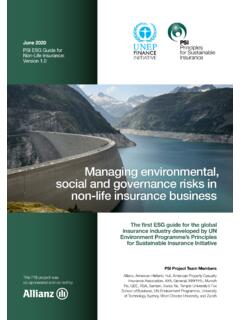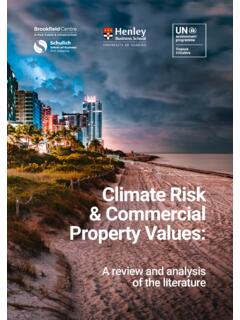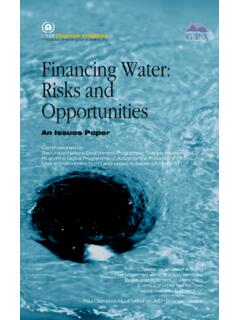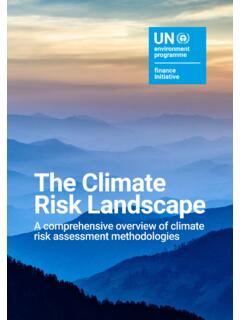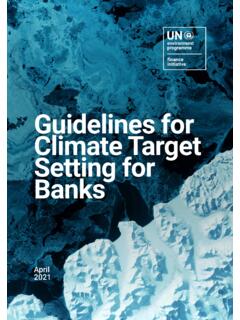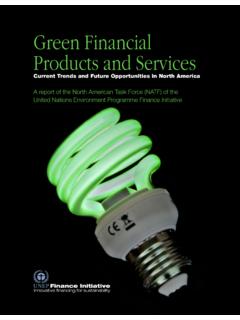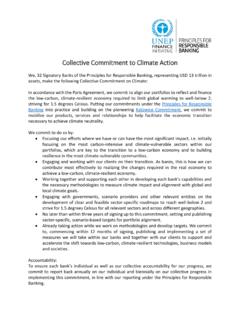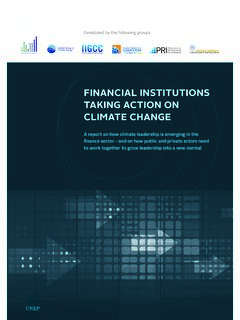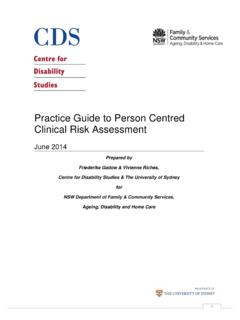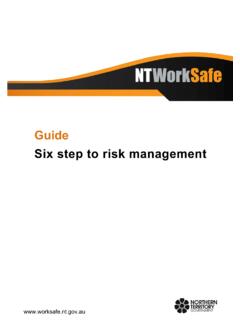Transcription of A comprehensive investor guide to scenario-based methods ...
1 1 Changing Course | |A comprehensive investor guide to scenario-based methods for climate risk assessment , in response to the TCFDMay 2019 Twenty institutional investors from eleven countries, convened by UNEP FI and supported by Carbon Delta, have worked throughout 2018 2019 to analyse, evaluate, and test, state-of-the-art methodologies to enable C, 2 C, and 3 C scenario-based analysis of their portfolios in line with the recommendations of the FSB s Task Force on Climate-related Financial Disclosures (TCFD). The outputs and conclusions of this Pilot are captured in the following report and aim to enhance the understanding and ease adoption of the TCFD recommendations by the wider investment Environment Finance Initiative is a partnership between UN Environment and the global financial sector created in the wake of the 1992 Earth Summit with a mission to promote sustainable finance.
2 More than 200 financial institutions, including banks, insurers, and investors, work with UN Environment to under-stand today s environmental, social and governance challenges, why they matter to finance, and how to actively partici-pate in addressing Economics is a strategic consul-tancy providing our private and public clients with deep sectoral and thematic expertise at the nexus of finance, commerce and the environment. For our financial sector clients, we provide policy and market intelligence, scenario model-ling, and risk and opportunity assessment tools that support investment strategy, risk management, investee engagement and financial Delta is a climate change data analytics firm that quantifies investment risks for more than 30,000 companies along numerous climate change scenarios.
3 With our Climate Value-at-Risk (CVaR) model we aim to em power financial institutions with the tools necessary to protect assets from the worst effects resulting from climate change and also help identify new, innovative low carbon investment Course | Contents |CONTENTSP erspectives from the pilot membership ..5 Foreword by Mark Carney ..7 Foreword by Satya Tripathi ..8 Acknowledgements ..9 Executive Summary ..101 Introduction ..162 Overview of methodologies ..233 Building blocks of the investor Pilot methodology ..384 Comparing Climate Value at Risk across C, 2 C and 3 C Worlds ..505 Operationalising the methodology: case studies ..656 Future directions ..116 Appendix I ..120 Appendix II ..121 Appendix III.
4 122 Acronyms ..123 Glossary ..124 References ..1252 Changing Course | Contents |LIST OF TABLEST able 1: Key innovative elements, gaps and next steps for the Carbon Delta methodology ..48 Table 2: Results for the Top 1,200 companies by global market cap ..51 Table 3: Sector-level results for Policy Risk illustrate the range of climate- related impacts across the portfolio ..52 Table 4: Sector-level results for Technology Opportunities illustrate the range of impacts across the portfolio ..53 Table 5: Policy Risk for a Delayed and Non-delayed scenario ..53 Table 6: Physical Risk for the average and aggressive climate models and each specific weather hazard ..54 Table 7: Physical Risk for the average scenario by sector and weight.
5 55 Table 8: Top 10 locations exposed to physical risks based on sector and hazard ..56 Table 9: Results for the Top 1,200 companies by global market cap ..58 Table 10: Sector-level results for Policy Risk illustrate the range of climate-related impacts across the portfolio ..58 Table 11: Sector-level results for Technology Opportunities illustrate the range of impacts across the portfolio ..59 Table 12: Policy risk for a delayed and non-delayed scenario ..59 Table 13: Physical Risk for the Average and Aggressive climate models and each specific weather hazard ..60 Table 14: Physical Risk for the average scenario by sector and contribution ..60 Table 15: Top 10 locations exposed to Physical risks based on sector and hazard.
6 61 Table 16: Results for a Coal Portfolio ..63 Table 17: Results for a Renewable Energy Portfolio ..63 Table 18: CDPQ comparison of sectors through specific value chains ..72 Table 19: CDPQ total VaR of cement and iron and steel sectors ..73 Table 20: Manulife Canadian equity portfolio results ..75 Table 21: Manulife Asian equity portfolio results ..75 Table 22: Manulife sector weights for Canadian and Asian equity portfolios ..76 Table 23: Manulife total portfolio VaR of these hazards for both portfolios ..77 Table 24: Manulife industry ranking by exposure to extreme heat risk ..77 Table 25: Manulife industry ranking by exposure to coastal flooding risk ..77 Table 26: Manulife industry ranking by exposure to tropical cyclone risk.
7 77 Table 27: Rockefeller portfolio CVaR results comparison ..84 Table 28: Investa NGA factors across Australian cities where portfolio is situated ..95 Table 29: Investa variance between energy intensity and emissions intensity across geographical differences ..96 Table 30: KLP estimated VaR for cumulative holdings in listed bonds and 31: La Fran aise CVaR portfolio analysis summary results ..106 Table 32: La Fran aise CVaR global reference index summary results ..107 Table 33: TDAM results under a 2 C scenario ..1123 LIST OF FIGURESF igure 1: Analytical elements of scenario-based impact assessments ..11 Figure 2: The TCFD recommendations are structured around four broad themes ..19 Figure 3: Analytical elements of scenario-based impact assessments.
8 24 Figure 4: Framework for categorisation of Physical Risk impact assessment methodologies ..27 Figure 5: Overview of Physical Risk assessment methodologies ..28 Figure 6: Framework for categorisation of Transition Risk impact assessment methodologies ..33 Figure 7: Overview of Transition Risk assessment methodologies ..34 Figure 8: The final outputs of the Carbon Delta methodology are quantified costs or revenues and the CVaR ..38 Figure 9: Carbon Delta assesses climate risk across two main pillars; transition effects and physical impacts ..39 Figure 10: Carbon Delta calculates climate costs and profits over the next 15 years, then assumes a linear decline ..46 Figure 11: Schematic display of Carbon Delta s warming potential calculation.
9 47 Figure 12: Anonymous company locations that are exposed to significant levels of acute physical climate risks ..56 Figure 13: Portfolio Temperature Gauge for Market Portfolio ..57 Figure 14: Anonymous company locations that are exposed to significant levels of acute physical climate risks ..61 Figure 15: Portfolio Temperature Gauge for Top 1,200 Companies ..62 Figure 16: Portfolio Temperature Gauge for Coal and Renewable Energy Portfolios ..64 Figure 17: Global average surface temperature changes relative to 1986-2005 ..68 Figure 18: Increase in damages as % of asset value from expected value to 95th percentile for coastal flooding ..69 Figure 19: Aviva analysis of differences between Average and Aggressive scenarios across physical hazards.
10 69 Figure 20: Warming projections to 2100 ..80 Figure 21: Nordea cost curves of the 2 C and Delayed scenarios ..81 Figure 22: Nordea VaR across sectors: not all costs are equally spread across sectors, but rather 23: DNB portfolio, scenario and results 24: Investa historical emissions performance and projected emissions trajectories under various scenarios ..93 Figure 25: Investa carbon emission reductions at Asset 1 and Asset 2 over the period FY12-FY18 ..94 Figure 26: Investa variance between energy intensity, emission intensity and VaR across geographies ..95 Figure 27: KLP s approach to climate risk assessment is structured in accordance with TCFD recommendations.
